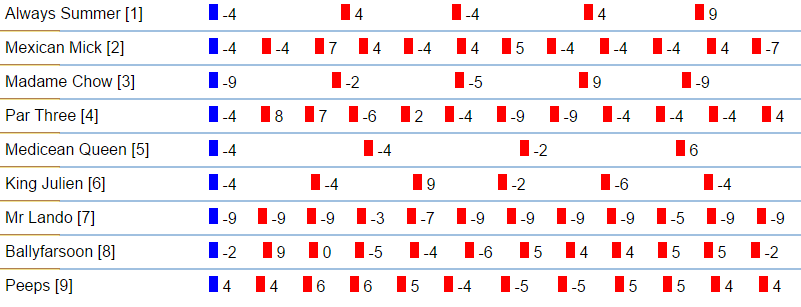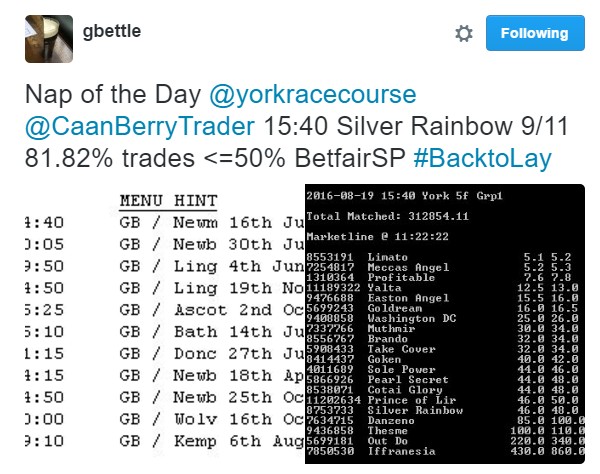Tipping a back to lay is becoming extremely popular. But why?
Because it’s so much easier to pick a horse that will lead, or at least travel better than its price than to choose the out-right winner.
There’s still plenty of punters (and traders) making a mess of it though. The problem is knowing what they’re doing, or having a clearly defined plan. So I’ve updated this original post from back in 2014 when Betfair asked me to share a simple strategy for their Pro Traders Campaign via the App’s directory.
By the end of this post, you’ll understand the five-step framework I consider when picking a back to lay trade and watched a live back to lay recording. It was recorded live for the pro traders campaign mentioned above. This blog is crammed with info, enjoy…
Points include:
- Analysing the race
- Choosing our back to lay selection
- Potential threats
- Formulating a strict execution plan
- Considering the what-if’s
Back to Lay Selections For Horse Racing:
Each day we post ‘possible’ front-runners via the Twitter and Facebook pages. If you don’t already, make sure you follow me to avoid missing them.
There’s also a daily page on the site here now: Front Runners Shortlist Page.
Backing to lay is a great way of winning a quick trade, for a fairly easy profit. Selection isn’t quite so fast, ruling out ‘maybe trades’ is vital. Strict routine and disciplined staking is the fastest way to succeed. Getting over-excited and breaking your own rules will land you in hot water every time, don’t do it.
There are a few useful resources mentioned throughout this post, I’d advise bookmarking them for future reference as you go. As with all trading, the more information you have available, the easier the decision-making process becomes. It’s science.
Analysing a Race’s Characteristics:
Before you even consider making a back to lay selection, it’s important to understand the race make-up. A six-furlong novice on the all-weather is going to present a wildly different opportunity to a three-mile jumps race. For a start, the six-furlong race will be over in a fraction of the time. Also, lightly raced horses are often less predictable. Where-as the old sweats tend to do the same thing every time, its logical right?
ProForm race cards are a useful tool to understand the make-up of a race. Previously they guest posted about them on this blog.
Considering the difference between a back to lay on the jumps and flat is another thought. Personally, I prefer the jumps, you can often tell both horse and jockeys intent around start time. Starting stalls present an additional problem if you want to back the leader. You don’t want to get stuck without an exit in an illiquid betting market.
Choosing Your Back to Lay Selection:
Picking the actual back to lay runner can be time-consuming. I’ve tried various different methods over the years, two sites saved me a lot of time though;
- Racing Alerts via GG.co.uk work really well as it’s possible to mark a specific horse for future reference. The evening before they’ll send you an email to tell you it runs again. Once you’ve built up a list of reliable back to lay horses it’s just a case of checking the inbox and skipping to the later steps of the selection process.
- Patternform pace cards can save a bit of time. You’ll have to be logged in to view them (free). If you haven’t much time and want to scroll through the days cards it can be done quite quickly. Just to find a stand-out pace horse.
So what are we looking for?
There are two different angles to take when choosing a back to lay. Firstly, and the most reliable in my experience is by choosing a consistent front-runner, in a race where it’s likely to get an uncontested lead. The second is based on the horse’s in-running price data. Let’s look at them both!
Front-Runners – Some horses are renowned for their running styles. They have personalities too! A bit like when you take a dog for a walk, horses get excited when they come onto the course. These horses are usually the best front-runners. Why? because it doesn’t matter what the jockey want’s so much, they’re going to lead anyway.
On the other hand, you may find a jockey pushing a horse to lead for various tactical reasons. Either way, if a horse has a history of leading by any kind of margin it’s usually worth looking at.
You can delve into a horse running style later, but it’s easily noticeable via the pattern form cards previously mentioned. Look at the example above, a 9 shows us the horse spent the majority of the race in the rear. And -9 is the other end of the spectrum, meaning the horse led previously.
It’s quite easy to see, in the example above Mr Lando is likely to lead this race. This alone isn’t enough to make a selection though, make sure you look into things deeper before parting with your cash!
Note: Don’t forget some flat tracks start close to a bend, it may be harder to lead from a wide draw.
In-Play Price History – A little more complex, unless you’re a data collection whizz. Sites like time-form will show a horses previous price history, some horses appear to ‘travel’ better than others regularly, although don’t win. If you follow me on twitter you’ll have seen some re-tweets from a follower that does this, Gary. See an example below;
The downside with following price history for your back to lay is it’s not so easy to tell when things aren’t going to plan. You’ll see why in a second…
Potential Problems
Finding a winning back to lay isn’t just about selecting the right horse, unfortunately.
It depends largely on the race it takes place in. For example, if your favoured front-runner is in a race where there are three other front-runners it’s going to cause problems. We’re relying on the market contracting in price because the horse has a distinct advantage over the rest at that point in time. So if there are three other horses attempting to do exactly the same, there is no advantage and therefore the price will not shorten. Make sense?
The same goes for the second back to lay strategy, except if you have several other horses that have a history of running strongly you’ll need to have a sharp eye in order to spot a potential threat to your trade.
Other problems include things like draw, trainer change or distance. From time to time trainers and jockeys will try different tactics with a horse, it’s more likely on the occasion they’ve just changed hands. For this reason, I’d always advise doing a little more homework after finding a potential back to lay.
Strict Execution Plan
I’m not sure where I first heard it, but it’s so true. “Edges are ten-a-penny, execution is everything”.
All the knowledge in the world won’t help you if you’ve not got a strict plan you’re willing to stick with. If you planned to open the trade at the start but you decide against it because several other horses look keen to lead and are walking to the tape ahead, that’s fine. But if the race begins and everything you expected to happen then does, it’s too late to enter, the horse has bolted! Let it go! don’t join in after the opportunity has passed. You might be frustrated, but you won’t be getting into a bad position.
Anticipating What If?
Maybe it’s the Army coming out in me but following the previous point, it’s always good to explore the potential problems and decide what you’re actions on are before the trade takes place.
Ask yourself a set of questions like this:
- What will I do if my selection doesn’t appear keen, or line up at the front by the tapes?
- How about other selections appearing overly keen at the start?
- What if the race starts and the jockey restrains the horse?
- What’s my reaction if the horse leads, but the price doesn’t move?
By thinking about it and deciding your answer to each question before the race, you won’t find yourself stuck on the fence if it starts to happen. I found this a very powerful way of avoiding them ‘rabbit in the headlights’ situations.
Now you’ll see my original back to lay post from some time ago. See if you can spot the framework I had set in place!
Live Example: Originally posted August 1st 2014
I don’t normally do this, and don’t consider myself a ‘tipster’. But tonight I’m going to put my head on the chopping block – if it goes wrong and you’ve followed on I’m sorry!
Back to Lay Tip Tonight
MUSSELBURGH 7.20 – Camerooney
Previous followers know I’ve mentioned this runner several times on Twitter. On a couple of occasions, an above-average result has been landed.
Camerooney is an out-and-out front-runner. Of his last 10 runs 9 times he has lead the race and once was ‘slightly’ off the lead.
See some previous runs here. Breaking from stall 2 I would expect him to hit the lead and take the rail early. Offering a fair drop in price, from there on he may well lead for the majority if not all of the race currently priced as the second favourite at 6.4.
Following my previous comment, you’ll know the key to picking a good back to lay isn’t just about the horse in question. But the race and how the other runners may be expected to behave.
Other Runners
- Dhaular Dhar – generally midfield/held up, stall 1.
- Ellaal – led last time although is generally a midfield/prominent racer. Last 9 runs before that weren’t ever more than ‘prominent’, stall 3. If anything I would have thought this runner may go with Camerooney but doesn’t show the same intent of trailblazing.
- Call Of Duty – hold up runner, every run of the last 10.
- Jordaura – again, hold up runner of the last 10.
- Royal Straight – another hold-up performer, has been mid-pack once or twice.
- Outlaw Torn – midfield/prominent style of running preferred. The horse breaks from stall 7 which isn’t a bad stall to come from but doesn’t have the advantage of getting the rail early. I wouldn’t have thought will be intent on taking on Cameroony.
- Janaab – this ones a little confusing as has led once. Has been held up on several occasions, run midfield although drawn in stall 8 is less likely to break and take the lead initially. I’ll be keeping an eye on this one for that reason just incase the jockey tries to pump it into the lead.
Threats: Competition
If Janaab, Outlaw Torn or Ellaal are pumped hard appearing to go for the lead by their respective jockey, it could be time to re-evaluate the situation. Of all of them I can only see these 3 attempting to go close to the lead. Camerooney is unlikely to need pushing as has the nature to lead anyway. The only other thing to bear in mind of course is if Camerooney is restrained early by Jordan Neson, looks unlikely.
Janaab would be the biggest threat to have an effect on the odds movement. If he also goes to the front it’s the biggest concern (if still the market leader at the start that is).
Action Plan:
In an ideal world, I’d like to see Camerooney on his toes at the start before loading to confirm he’s up for it. When the stalls break if he bounces early and grabs the rail I’ll have that warm fuzzy feeling going on. Hopefully, Janaab and Outlaw Torn will settle for midfield while he blazes ahead. If they don’t I’ll be looking to take out a portion of my initial bet at SP, probably 15 – 30 seconds into the race depending on how the market reacts.
From there it will of offset my position minimising any potential loss should it go tits up. Afterwards its a case of re-assessing the race. Should the others be several lengths behind Camerooney I’ll look to let it run that bit more and get out for a large result in terms of % stake. If they’re bunching up behind I’ll just take what I’m given… it’s important to not get too excited when its going well as you can burn profit quite easily.
Actions On ‘What if’
Should Cameroony breaks slowly or another horse appears to get the lead I’ll be looking to get out fast if he shows no intent to be bouncing ahead I’ll also get out. However, if Janaab breaks well and comes across in front I’ll get out… I’m sure you get the picture!
One thing to bear in mind is this is a very obvious front-runner, there will probably be quite a few people doing the similar! Should it go a bit wrong you could see the market over-react with people panicking to lay off their initial bets, for that reason don’t over stake!!
Good luck! and don’t blame me if it goes wrong… no doubt I’ll of lost some money too!
If you’ve just found this page and haven’t a clue what a Back to lay is this LINK should help!
UPDATE: Watch My Trade Below!




14 thoughts on “5-Point Checklist: Back to Lay Tips (Plus Live Trade)”
Good job Caan!
I made nice profit at MUSSELBURGH 7.20 – Camerooney. Made £18 with £10 stake. Nice!
Thank you!
Thanks Jordan. That’s a pretty big return!
Great work sir !
Thanks Nick 🙂
Whats the best software for training??
Good evening Mr. Caan,
I am interested in trading on horse racing.
Given your publication you have a lot of experience, that’s what impresses me.
Through you, I would like to know what is your daily work routine for trading?
How do you analyze the markets before trading?
your methodology every morning
What tools do you use for analysis?
How do you manage your capital, the money management?
How much do you risk for a race?
Example for someone who has a capital of 1000 euros how much is it advisable to risk per race?
My wish is that you train me but I have a problem. I do not speak English well
I count on you
Cordially.
Alain
Hi Alain,
Hell of a lot to answer there! All of which is in this book though: https://www.amazon.co.uk/Betfair-Trading-Made-Simple-Ultimate/dp/1980887039/
The biggest pitfall in National Hunt front runner in-play betting is meticulously focusing on your strategy, getting your stake and exit points just right…….then your selection falls at a fence and in an instant you are helpless and also considerably poorer! Pre-race trading is really a lot safer, in my opinion. Keep up the good work Caan, you are simply the number one helpful tips person bar none! Andy.
Hi Caan
I bought your book some time ago will reread now to see if it will sink in, don’t expect to much being 84 years of age would like to leave my family a bit of money but most of all for them to make some money them selves in the future .
Kind Regards Henry Grant.
who’s this c berry
whats a pre race bet n how can i learn to do it
Can this work in Australia which doesn’t allow in race betting?
Are there other strategies we can look for?
Lay betting tips
Can get backing on lay for all horses racing